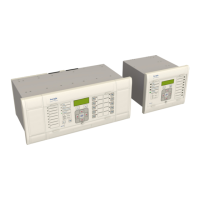Measurement Mode Parameter Signing
3
Export Power
Impor
t Power
Lagging Vars
Leading VArs
–
+
–
+
The device also calculates the per-phase and three-phase power factors.
These pow
er values increment the total real and total reactive energy measurements. Separate energy
measurements are maintained for the total exported and imported energy. The energy measurements are
incremented up to maximum values of 1000 GWhr or 1000 GVARhr at which point they reset to zero. It is possible
to reset these values using the menu or remote interfaces using the Reset demand cell.
These measurements are contained in the MEASUREMENTS 2 column.
4.1.4 DEMAND VALUES
The device produces fixed, rolling, and peak demand values. You reset these quantities using the R
eset demand
cell.
The fixed demand value is the average value of a quantity over the specified interval. Values are produced for
three phase real and reactive power. The fixed demand values displayed are those for the previous interval. The
values are updated at the end of the fixed demand period according to the Fix Dem Period setting in the
MEASURE'T SETUP column.
The rolling demand values are similar to the fixed demand values, but a sliding window is used. The rolling demand
window consists of a number of smaller sub-periods. The resolution of the sliding window is the sub-period length,
with the displayed values being updated at the end of each of the sub-periods according to the Roll Sub Period
setting in the MEASURE'T SETUP column.
Peak demand values are produced for each phase current and the real and reactive power quantities. These
display the maximum value of the measured quantity since the last reset of the demand values.
These measurements are contained in the MEASUREMENTS 2 column.
4.1.5 OTHER MEASUREMENTS
Depending on the model, the device produces a range of other measurements such as thermal measurements.
These measur
ements are contained in the MEASUREMENTS 3 column.
4.2 MEASUREMENT SETUP
You can define the way measurements are set up and displayed using the ME
ASURE'T SETUP column and the
measurements are shown in the relevant MEASUREMENTS tables.
4.3 OPTO-INPUT TIME STAMPING
Each opto-input sample is time stamped within a tolerance of +/- 1 ms with respect to the Real Time Clock. These
time stamps ar
e used for the opto event logs and for the disturbance recording. The device needs to be
synchronised accurately to an external clock source such as an IRIG-B signal or a master clock signal provided in
the relevant data protocol.
For both the filtered and unfiltered opto-inputs, the time stamp of an opto-input change event is the sampling time
at which the change of state occurred. If multiple opto-inputs change state at the same sampling interval, these
state changes are reported as a single event.
P64x Chapter 13 - Monitoring and Control
P64x-TM-EN-1.3 275

